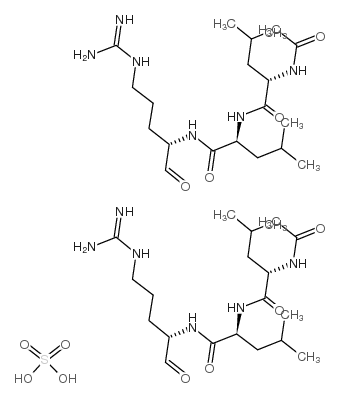| Description |
Leupeptin is a broad-spectrum, membrane-permeable protease inhibitor. Leupeptin potently inhibits serine, cysteine and threonine proteases. Leupeptin inhibits Mpro (the main protease of SARS-CoV-2) and also has anti-inflammatory activity[1][2][3].
|
| Related Catalog |
|
| Target |
Cathepsin B, Cathepsin H, Cathepsin L, Ser/Thr Protease, Mpro[1][2][3].
|
| In Vitro |
Leupeptin (0.06-200 µM; 72 h) 显著抑制 Vero 细胞中 SARS-CoV-2 病毒 RNA (vRNA) 的拷贝数[1] 。Leupeptin 抑制 Vero 细胞中 SARS-CoV-2 的 RNA 水平,EC50 值为 42.34 µM[1] 。Leupeptin 对 Mpro 有一定的抑制活性,其 IC50 值为127.2 µM[1] 。Leupeptin 对人类冠状病毒 229E 株的 IC50 值为 0.4 µg/mL (约 1 µM)[1]。 RT-PCR[1] Cell Line: Vero cells Concentration: 0.06-200 µM Incubation Time: 72 h Result: Significantly decreased copy numbers of SARS-CoV-2 viral RNA (vRNA).
|
| In Vivo |
Leupeptin (0, 9, 18, 36 mg/kg; i.p.; single) 具有很好的动物耐受性,并在总组织提取物、溶酶体以及富含自噬体的颗粒部分以剂量依赖的方式显著诱导 LC3b-II 的增加[2]。 Animal Model: C57BL/6NCrl male mice (6-8 weeks old, 20-25 g)[1]. Dosage: 0, 9, 18, 36 mg/kg Administration: Intraperitoneal injection; single Result: Promoted the accumulation of LC3b-II in mouse liver.
|
| References |
[1]. Fu L, et al. Mechanism of Microbial Metabolite Leupeptin in the Treatment of COVID-19 by Traditional Chinese Medicine Herbs. mBio. 2021 Oct 26;12(5):e0222021. [2]. Haspel J, et al. Characterization of macroautophagic flux in vivo using a leupeptin-based assay. Autophagy. 2011 Jun;7(6):629-42. [3]. Aoyagi T, et al. Biological activities of leupeptins. J Antibiot (Tokyo). 1969 Nov;22(11):558-68.
|


